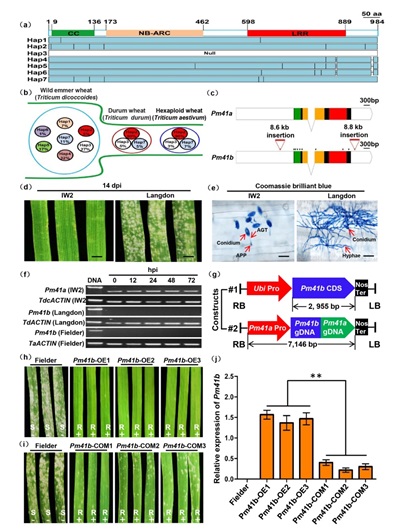Wheat genetic diversity has been narrowed throughout its entire existence due to two sequential polyploidization events followed by domestication, therefore profoundly limiting its improvement, like pathogen resistance. However, wheat has a huge allohexaploid genome (AABBDD, 16 Gb), which hid abundantly silenced genes, or SLEEPING BEAUTIES, due to transposon insertion, epigenetic modification and other reasons elsewhere in the genome. Therefore, provoking of these hidden treasure genes through genetic engineering will greatly enrich the gene pool for wheat improvement.
Recently, research groups of Prof. Dr. LIU Zhiyong and Prof. Dr. ZHAO Yusheng from the Institute of Genetics and Developmental Biology (IGDB), Chinese Academy of Sciences proposed a novel idea to reactivate or awake those silenced genes / SLEEPING BEAUTIES for wheat improvement by provoking a silent R gene in wheat genome confers resistance to powdery mildew, one of the most widely epidemic diseases in wheat (Triticum aestivum) caused by Blumeria graminis f. sp. tritici (Bgt).
Previously, the research group cloned the powdery mildew resistance gene Pm41 (Pm41a) from wild emmer wheat (WEW), the progenitor of common wheat. Pm41a showed high resistance to more than 80% of the Bgt isolates collected from different natural ecological zones in China. After performing haplotypic analysis, they found 7 haplotypes (Hap1 to Hap7) for the Pm41 locus in the WEW populations. However, only three haplotypes, Hap2 (Pm41b, 90%), Hap3 (Null, 5%) and Hap7 (5%), were identified in durum and hexaploid wheat populations, suggesting loss of genetic diversity of Pm41 locus due to domestication and polyploidization bottleneck. Detailed analysis showed that Hap2, Hap4 to Hap7 carrying two DNA transposons inserted in the promoter and 3′-UTR regions, respectively, but containing an intact Pm41 allelic coding region sequence without expression before or after Bgt isolate inoculation.
To further explore the functionality of Pm41b in vivo, as well as its possibility of application in wheat breeding, they developed transgenic wheat plants carrying the Pm41b driven either by the Pm41a promoter or by the constitutively expressing promoter of ubiquitin from maize (Zea mays L.). Interestingly, both types of transgenic wheat plants were highly resistance to powdery mildew. In addition, the increased powdery mildew resistance of Pm41b-OE and Pm41-COM transgenic plants did not impact on major agronomic traits. The above results imply that the silent genetic loci like Pm41b are valuable resource of genetic variation in wheat genome, and therefore could be potentially utilized to enrich the genetic diversity in wheat breeding.
This work sheds a light on how to wake up and make use of those SLEEPING BEAUTIES in wheat genome. It provides an intriguing approach to exploit genetic diversity, which is extremely narrowing and being a barrier of crop improvement in modern crop cultivars. The emergence of precise genome editing tools will offer more efficient approaches to directly modulate these silent but useful loci in modern cultivars and booster the modern crop breeding for food sustainability.
The study entitled “Provoking a silent R gene in wheat genome confers resistance to powdery mildew” was published in Plant Biotechnology Journal on July 29th, 2022 (doi: 10.1111/pbi.13903).
This work was financially supported by the National Natural Science Foundation of China (32101735), Hainan Yazhou Bay Seed Laboratory (B21HJ0111), Chinese Academy of Sciences and State Key Laboratory of Plant Cell and Chromosome Engineering.
Provoking a silent R gene in wheat genome confers resistance to powdery mildew (Image by IGDB)
Contact:
Dr. LIU Zhiyong
Institute of Genetics and Developmental Biology, Chinese Academy of Sciences
 Provoking a silent R gene in wheat genome confers resistance to powdery mildew (Image by IGDB)Contact:Dr. LIU ZhiyongInstitute of Genetics and Developmental Biology, Chinese Academy of SciencesEmail: zyliu@genetics.ac.cn
Provoking a silent R gene in wheat genome confers resistance to powdery mildew (Image by IGDB)Contact:Dr. LIU ZhiyongInstitute of Genetics and Developmental Biology, Chinese Academy of SciencesEmail: zyliu@genetics.ac.cn CAS
CAS
 中文
中文




.png)
